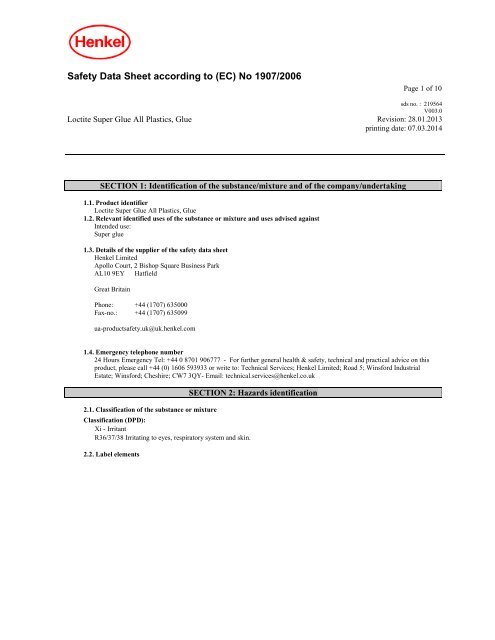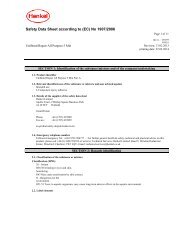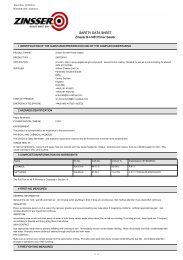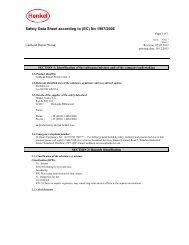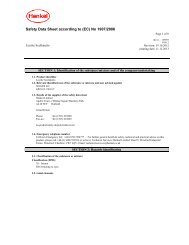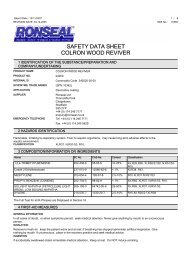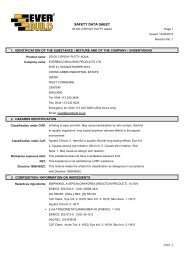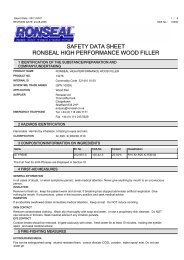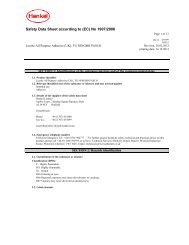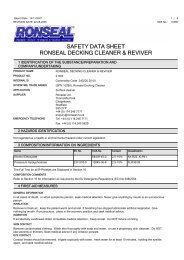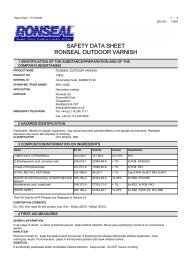SAFETY DATA SHEET LOCTITE ALL PLASTICS - Toolbank
SAFETY DATA SHEET LOCTITE ALL PLASTICS - Toolbank
SAFETY DATA SHEET LOCTITE ALL PLASTICS - Toolbank
Create successful ePaper yourself
Turn your PDF publications into a flip-book with our unique Google optimized e-Paper software.
Safety Data Sheet according to (EC) No 1907/2006Loctite Super Glue All Plastics, GluePage 1 of 10sds no. : 219564V003.0Revision: 28.01.2013printing date: 07.03.2014SECTION 1: Identification of the substance/mixture and of the company/undertaking1.1. Product identifierLoctite Super Glue All Plastics, Glue1.2. Relevant identified uses of the substance or mixture and uses advised againstIntended use:Super glue1.3. Details of the supplier of the safety data sheetHenkel LimitedApollo Court, 2 Bishop Square Business ParkAL10 9EY HatfieldGreat BritainPhone: +44 (1707) 635000Fax-no.: +44 (1707) 635099ua-productsafety.uk@uk.henkel.com1.4. Emergency telephone number24 Hours Emergency Tel: +44 0 8701 906777 - For further general health & safety, technical and practical advice on thisproduct, please call +44 (0) 1606 593933 or write to: Technical Services; Henkel Limited; Road 5; Winsford IndustrialEstate; Winsford; Cheshire; CW7 3QY- Email: technical.services@henkel.co.ukSECTION 2: Hazards identification2.1. Classification of the substance or mixtureClassification (DPD):Xi - IrritantR36/37/38 Irritating to eyes, respiratory system and skin.2.2. Label elements
MSDS-No.: 219564V003.0Loctite Super Glue All Plastics, Glue Page 2 of 10Label elements (DPD):Xi - IrritantRisk phrases:R36/37/38 Irritating to eyes, respiratory system and skin.Safety phrases:S2 Keep out of the reach of children.S23 Do not breathe vapour.S24/25 Avoid contact with skin and eyes.S26 In case of contact with eyes, rinse immediately with plenty of water and seek medical advice.Additional labeling:Cyanoacrylate. Danger. Bonds skin and eyes in seconds. Keep out of the reach of children.2.3. Other hazardsPersons suffering from allergic reactions to acrylates should avoid contact with the product.General chemical description:Super glueBase substances of preparation:CyanoacrylateSECTION 3: Composition/information on ingredientsDeclaration of the ingredients according to CLP (EC) No 1272/2008:Hazardous componentsCAS-No.Ethyl 2-cyanoacrylate7085-85-0EC NumberREACH-Reg No.230-391-501-2119527766-29contentClassification> 80- < 100 % Serious eye irritation 2H319Specific target organ toxicity - singleexposure 3H335Skin irritation 2H315For full text of the H - statements and other abbreviations see section 16 "Other information".Substances without classification may have community workplace exposure limits available.Declaration of ingredients according to DPD (EC) No 1999/45:Hazardous componentsCAS-No.Ethyl 2-cyanoacrylate7085-85-0EC NumberREACH-Reg No.230-391-501-2119527766-29contentClassification> 80 - < 100 % Xi - Irritant; R36/37/38For full text of the R-Phrases indicated by codes see section 16 'Other Information'.Substances without classification may have community workplace exposure limits available.
MSDS-No.: 219564V003.0Loctite Super Glue All Plastics, Glue Page 3 of 10SECTION 4: First aid measures4.1. Description of first aid measuresGeneral information:In case of adverse health effects seek medical advice.Inhalation:Move to fresh air, consult doctor if complaint persists.Skin contact:Do not pull bonded skin apart. It may be gently peeled apart using a blunt object such as a spoon, preferably after soaking inwarm soapy water.Cyanoacrylates give off heat on solidification. In rare cases a large drop will generate enough heat to cause a burn.Burns should be treated normally after the adhesive has been removed from the skin.If lips are accidentally stuck together apply warm water to the lips and encourage maximum wetting and pressure from salivainside the mouth.Peel or roll lips apart. Do not try to pull the lips apart with direct opposing action.Eye contact:If the eye is bonded closed, release eyelashes with warm water by covering with wet pad.Cyanoacrylate will bond to eye protein and will cause periods of weeping which will help to debond the adhesive.Keep eye covered until debonding is complete, usually within 1-3 days.Do not force eye open. Medical advice should be sought in case solid particles of cyanoacrylate trapped behind the eyelidcause any abrasive damage.Ingestion:Ensure that breathing passages are not obstructed. The product will polymerise immediately in the mouth making it almostimpossible to swallow. Saliva will slowly separate the solidified product from the mouth (several hours).4.2. Most important symptoms and effects, both acute and delayedEYE: Irritation, conjunctivitis.SKIN: Redness, inflammation.RESPIRATORY: Irritation, coughing, shortness of breath, chest tightness.4.3. Indication of any immediate medical attention and special treatment neededSee section: Description of first aid measuresSECTION 5: Firefighting measures5.1. Extinguishing mediaSuitable extinguishing media:carbon dioxide, foam, powder, water spray jet, fine water sprayExtinguishing media which must not be used for safety reasons:High pressure waterjet5.2. Special hazards arising from the substance or mixtureIn the event of a fire, carbon monoxide (CO) and carbon dioxide (CO2) can be released.5.3. Advice for firefightersWear protective equipment.Wear self-contained breathing apparatus.SECTION 6: Accidental release measures
MSDS-No.: 219564V003.0Loctite Super Glue All Plastics, Glue Page 4 of 106.1. Personal precautions, protective equipment and emergency proceduresWear protective equipment.Ensure adequate ventilation.Avoid contact with skin and eyes.Danger of slipping on spilled product.6.2. Environmental precautionsDo not let product enter drains.6.3. Methods and material for containment and cleaning upRemove with liquid-absorbing material (sand, peat, sawdust).Dispose of contaminated material as waste according to Chapter 13.6.4. Reference to other sectionsSee advice in chapter 87.1. Precautions for safe handlingOpen and handle container with care.Avoid skin and eye contact.Ensure that workrooms are adequately ventilated.Hygiene measures:Do not eat, drink or smoke while working.Wash hands before work breaks and after finishing work.SECTION 7: Handling and storage7.2. Conditions for safe storage, including any incompatibilitiesFor optimum shelf life store in original containers under refrigerated conditions at 2 - 8°C (35.6 - 46.4 °F)Store in a dry place.Keep container tightly sealed and store in a frost free place.Store in a cool place, max. storage temperature 30°C.Do not store together with food or other consumables (coffee, tea, tobacco, etc.).7.3. Specific end use(s)Super glueSECTION 8: Exposure controls/personal protection8.1. Control parametersOccupational Exposure LimitsValid forGreat BritainIngredient ppm mg/m 3 Type Category RemarksETHYL CYANOACRYLATE0,3 1,5 Short Term ExposureEH40 WEL7085-85-0Limit (STEL):
MSDS-No.: 219564V003.0Loctite Super Glue All Plastics, Glue Page 5 of 10Derived No-Effect Level (DNEL):Name on listEthyl 2-cyanoacrylate7085-85-0Ethyl 2-cyanoacrylate7085-85-0Ethyl 2-cyanoacrylate7085-85-0Ethyl 2-cyanoacrylate7085-85-0ApplicationAreaRoute ofExposureHealth Effectworker inhalation Long termexposure - localeffectsworker inhalation Long termexposure -systemic effectsgeneral inhalation Long termpopulationexposure - localeffectsgeneralpopulationinhalationLong termexposure -systemic effectsExposureTimeValue9,25 mg/m39,25 mg/m39,25 mg/m39,25 mg/m3RemarksBiological Exposure Indices:None8.2. Exposure controls:Respiratory protection:Suitable breathing mask when there is inadequate ventilation.Combination filter: ABEKPThis recommendation should be matched to local conditions.Hand protection:Recommended are gloves made from Nitril rubber ( Material thickness >0,1 mm, Perforation time < 30s).Gloves should bereplaced after each short time contact or contamination. Available at laboratory specialized trade or at pharmacies / chemist'sshops.In the case of longer contact protective gloves made from nitrile rubber are recommended according to EN 374.material thickness > 0.4 mmPerforation time > 30 minutesIn the case of longer and repeated contact please note that in practice the penetration times may be considerably shorter thanthose determined according to EN 374. The protective gloves must always be checked for their suitability for use at thespecific workplace (e.g. mechanical and thermal stress, product compatibility, antistatic effects, etc.). The gloves must bereplaced immediately at the first signs of wear and tear. The information provided by the manufacturers and given in therelevant trade association regulations for industrial safety must always be observed. We recommend that a hand care plan isdrawn up in cooperation with a glove manufacturer and the trade association in accordance with the local operatingconditions.Eye protection:Goggles which can be tightly sealed.Skin protection:Suitable protective clothingSECTION 9: Physical and chemical properties9.1. Information on basic physical and chemical propertiesAppearanceliquidcolourlessOdorirritatingOdour thresholdNo data available / Not applicablepHInitial boiling pointFlash pointDecomposition temperatureVapour pressureDensity(20 °C (68 °F))Bulk densityViscositynot applicable> 149 °C (> 300.2 °F)80 - 93,4 °C (176 - 200.12 °F); Tagliabue closed cupNo data available / Not applicable0,27 mbar1,05 g/cm3No data available / Not applicableNo data available / Not applicable
MSDS-No.: 219564V003.0Loctite Super Glue All Plastics, Glue Page 6 of 10Viscosity (kinematic)Explosive propertiesSolubility (qualitative)(Solvent: Acetone)Solubility (qualitative)(Solvent: Water)Solidification temperatureMelting pointFlammabilityAuto-ignition temperatureExplosive limitsPartition coefficient: n-octanol/waterEvaporation rateVapor densityOxidising propertiesNo data available / Not applicableNo data available / Not applicableMisciblePolymerises in presence of water.No data available / Not applicableNo data available / Not applicableNo data available / Not applicableNo data available / Not applicableNo data available / Not applicableNo data available / Not applicableNo data available / Not applicableNo data available / Not applicableNo data available / Not applicable9.2. Other informationIgnition temperature485 °C (905 °F)SECTION 10: Stability and reactivity10.1. ReactivityRapid exothermic polymerization will occur in the presence of water, amines, alkalis and alcohols.10.2. Chemical stabilityStable under recommended storage conditions.10.3. Possibility of hazardous reactionsSee section reactivity10.4. Conditions to avoidNone if used for intended purpose.10.5. Incompatible materialsNone if used properly.10.6. Hazardous decomposition productscarbon oxides.11.1. Information on toxicological effectsSECTION 11: Toxicological informationGeneral toxicological information:The preparation is classified based on the conventional method outlined in Article 6(1)(a) of Directive 1999/45/EC. Relevantavailable health/ecological information for the substances listed under Section 3 is provided in the following.Inhalative toxicity:Irritating to respiratory systemSkin irritation:Primary skin irritation: irritatingEye irritation:Primary eye irritation: irritatingSensitizing:An allergic reaction cannot be excluded after repeated skin contact.Acute oral toxicity:Hazardous componentsCAS-No.Ethyl 2-cyanoacrylate7085-85-0ValuetypeValue Route ofapplicationExposuretimeSpecies MethodLD50 > 5.000 mg/kg oral rat OECD Guideline 401 (AcuteOral Toxicity)
MSDS-No.: 219564V003.0Loctite Super Glue All Plastics, Glue Page 7 of 10Acute dermal toxicity:Hazardous componentsCAS-No.Ethyl 2-cyanoacrylate7085-85-0ValuetypeValue Route ofapplicationExposuretimeSpecies MethodLD50 > 2.000 mg/kg dermal rabbit OECD Guideline 402 (AcuteDermal Toxicity)Skin corrosion/irritation:Hazardous componentsCAS-No.Ethyl 2-cyanoacrylate7085-85-0ResultExposuretimeSpecies Methodslightly irritating 24 h rabbit OECD Guideline 404 (AcuteDermal Irritation / Corrosion)Serious eye damage/irritation:Hazardous componentsCAS-No.Ethyl 2-cyanoacrylate7085-85-0ResultExposuretimeSpecies Methodirritating 72 h rabbit OECD Guideline 405 (AcuteEye Irritation / Corrosion)Germ cell mutagenicity:Hazardous componentsCAS-No.Ethyl 2-cyanoacrylate7085-85-0Result Type of study /Route ofadministrationnegative in vitro mammalianchromosomeaberration testnegative bacterial reversemutation assay (e.gAmes test)negative mammalian cellgene mutation assayMetabolicactivation /Exposure timewith and withoutwith and withoutSpeciesMethodOECD Guideline 473 (In vitroMammalian ChromosomeAberration Test)OECD Guideline 471(Bacterial Reverse MutationAssay)OECD Guideline 476 (In vitroMammalian Cell GeneMutation Test)SECTION 12: Ecological informationGeneral ecological information:The preparation is classified based on the conventional method outlined in Article 6(1)(a) of Directive 1999/45/EC. Relevantavailable health/ecological information for the substances listed under Section 3 is provided in the following.Do not empty into drains, soil or bodies of water.12.1. ToxicityNo data available.12.2. Persistence and degradabilityHazardous componentsCAS-No.Ethyl 2-cyanoacrylate7085-85-0ResultRoute ofapplicationDegradability Methodaerobic 57 % OECD Guideline 301 D (ReadyBiodegradability: Closed BottleTest)12.3. Bioaccumulative potential / 12.4. Mobility in soilHazardous componentsCAS-No.Ethyl 2-cyanoacrylate7085-85-0LogKow Bioconcentrationfactor (BCF)ExposuretimeSpecies Temperature Method0,776 22 °C EU Method A.8 (PartitionCoefficient)12.5. Results of PBT and vPvB assessment
MSDS-No.: 219564V003.0Loctite Super Glue All Plastics, Glue Page 8 of 10No data available.12.6. Other adverse effectsNo data available.SECTION 13: Disposal considerations13.1. Waste treatment methodsProduct disposal:Dispose of waste and residues in accordance with local authority requirements.Disposal of uncleaned packages:Use packages for recycling only when totally empty.Waste code08 04 09 waste adhesives and sealants containing organic solvents and other dangerous substances
MSDS-No.: 219564V003.0Loctite Super Glue All Plastics, Glue Page 9 of 10SECTION 14: Transport information14.1. UN numberADR Not dangerous goodsRIDNot dangerous goodsADNR Not dangerous goodsIMDG Not dangerous goodsIATA 333414.2. UN proper shipping nameADRRIDADNRIMDGIATANot dangerous goodsNot dangerous goodsNot dangerous goodsNot dangerous goodsAviation regulated liquid, n.o.s. (Cyanoacrylate ester)14.3. Transport hazard class(es)ADR Not dangerous goodsRIDNot dangerous goodsADNR Not dangerous goodsIMDG Not dangerous goodsIATA 9914.4. Packaging groupADRRIDADNRIMDGIATANot dangerous goodsNot dangerous goodsNot dangerous goodsNot dangerous goodsIII14.5. Environmental hazardsADRRIDADNRIMDGIATAnot applicablenot applicablenot applicablenot applicablenot applicable14.6. Special precautions for userADRRIDADNRIMDGIATAnot applicablenot applicablenot applicablenot applicablenot applicable14.7. Transport in bulk according to Annex II of MARPOL 73/78 and the IBC Codenot applicableSECTION 15: Regulatory information15.1. Safety, health and environmental regulations/legislation specific for the substance or mixture15.2. Chemical safety assessmentA chemical safety assessment has not been carried out.
MSDS-No.: 219564V003.0Loctite Super Glue All Plastics, Glue Page 10 of 10SECTION 16: Other informationThe labelling of the product is indicated in Section 2. The full textof all abbreviations indicated by codes in this safety data sheet are as follows:R36/37/38 Irritating to eyes, respiratory system and skin.H315 Causes skin irritation.H319 Causes serious eye irritation.H335 May cause respiratory irritation.Further information:This information is based on our current level of knowledge and relates to the product in the state in which it is delivered. It isintended to describe our products from the point of view of safety requirements and is not intended to guarantee anyparticular properties.


